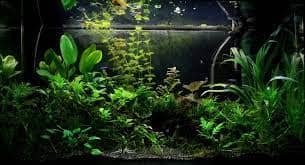When it comes to floating plants in the aquarium or garden pond, most people immediately think of the well-known duckweed. However, anyone who deals a little more intensively with the topic of aquarium plants will quickly discover many other attractive species. In this article, we will introduce you to some of them and tell you why you should not do without them.
Shade areas in the aquarium with floating plants
It is not always easy to satisfy the different needs of different aquarium plants. Some need a lot of light, others, especially slow-growing plants, start to grow algae if the light is too strong. Floating aquatic plants are the ideal solution for shading individual areas in the aquarium. In this way, you ensure an interesting play of light, prevent the growth of algae and offer shy fish an opportunity to retreat to a darker region in the aquarium.
Tip: A fishing line or thin twine can be used to demarcate an area on the water surface. In this way, the plants do not drift freely through the tank. This trick is more suitable for larger floating plants such as mussel flowers.
Prevent algae growth with aquarium plants
Algae quickly spread to slow-growing plants, decorative objects, and even the substrate if the lighting in the aquarium is too strong. Floating plants provide a simple and efficient remedy – and if you wish, only in certain areas of the pool.
But this is not the only reason why they are an important aid in the fight against algae in the aquarium: Fast-growing floating aquatic plants are particularly valuable as nutrient consumers. Duckweed or fairy ferns, for example, grow so rapidly with a good supply of nutrients that the stock has to be thinned out regularly. They convert excess nutrients into plant matter. Simply remove the plants from the aquarium regularly and ensure balanced water values.
Tip: If you find that the floating plants in your aquarium are only growing slowly, or the stock is even declining, you should check the water parameters and fertilize if necessary. They are a good indicator of whether there are enough nutrients in the water.
Protection for aquarium inhabitants
Floating aquatic plants cover the water surface in the aquarium and make the fish feel comfortable. Even shy specimens come out much more often when protected by a blanket of floating plants. In nature, many dangers lurk “from above”. They often feel safer in a densely planted tank – and it shows.
Young fish use the dense planting as a hiding place. The roots of floating aquarium plants become a safe haven. So you can look forward to significantly more offspring in your fish and other aquarium inhabitants.
Floating plants in the aquarium create an interesting look
The human observer also enjoys an aquarium with a versatile look. Floating plants offer many opportunities to structure the aquarium and make it interesting. Some species develop pretty, bushy roots that hang down into the water, making for an intriguing sight. In many species, these are even reddish in color.
Open aquariums are particularly attractive with floating plants. A plant cover is a real eye-catcher and ensures a varied overall picture – especially if it is a specimen that flowers every now and then.
These are just a few of the most popular floating plants for the aquarium and pond. You can get more species and information about caring for them from your specialist dealer for aquarium plants.
What do you think is the most beautiful floating plant in the aquarium? We welcome comments!





